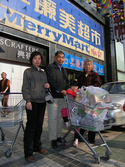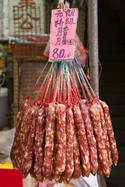Looking behind the tiger takeaway
12 January 2009Greg Wood, Managing Director, Edge (consultancy division of STFI-Packforsk), shares some insights from the food packaging section of the China 2012 report
In 2001, McKinsey predicted that China's retail market would be dominated by a handful of multinational giants. Seven years on, China's local retailers are still dominant, with only Carrefour in the top 10, although Tesco makes the top 20. Making market forecasts is always fraught with difficulties, but given that this prediction reflected the ambitions and strategic plans of the major retailers, why has this proved to be so far removed from reality?
A key factor is that retailers underestimated the significance of the differences between the Western and Eastern markets. Not only does consumer purchasing behaviour differ, but supply chain infrastructure poses different logistics challenges to those in the West. The message here for all businesses is that simply transferring business models from the West to the East is unlikely to work at this stage in China's development.
This is a significant indicator, both for brand owners wishing to sell their packaged products on the burgeoning Chinese marketplace, and for packaging manufacturers wishing to produce and supply their materials in the country. China is a diverse, complex and rapidly emerging economy, full of apparent contradictions and data minefields. This makes it awkward to interpret information without inside knowledge and specific information on the packaging sector.
The Edge market report, China 2012, is based on analysis of data from Chinese sources, supplemented by primary research. These sources comprise Chinese national statistics, packaging and packaging end-user statistics, business databases, newspapers and magazines, seminar and conference proceedings and company annual reports. The principal interviewees for the primary research were state officials, heads of Chinese packaging associations and heads and representatives of leading companies.
Predictions for food
China's packaging market is the largest in the world, and is predicted to grow to €75bn (£70.9bn) per annum by 2012. The research found that food packaging accounts for half of the total demand for packaging, with significant growth forecast over the next four years. Volume growth of more than 20 per cent is common in most food sectors. Most food manufacturing divisions in China are dominated by giant manufacturers, with a high degree of market concentration. For example, the top three instant noodle manufacturers accounted for 69.8 per cent of sales by value in 2006, up from 66.7 per cent the previous year. Similar trends in concentration are seen in other key markets, such as sandwich crackers.
Central planning is still a key feature in Chinese industry, and this creates some interesting market dynamics. A key driver behind growth in food packaging is the China Industry Eleventh Five Year Plan. According to this, a growth level of 15 per cent will be maintained until 2010, although actual growth may be a little higher than this. Edge estimates that, by 2012, the packaged foods market will total 119.6 million tonnes by volume.
During the next five years, this expanding packaged food industry will bring the packaging industry at least a 10 per cent stable annual growth, and the growth demand for some packaging products is likely to exceed 20 per cent. Demand for flexible plastics, folding cartons and corrugated cases will be highest.
Supply chain issues
Based on these volume figures, the packaged food market in China stands out as an attractive target for packaging manufacturers. There is certainly a large and expanding market for food packaging, and this is a real opportunity. The pace of change has been speedy. Just 20 years ago, no Chinese meat was packaged, but now increasing numbers of Chinese consumers are paying greater attention to food safety. People are gradually changing their attitudes and becoming aware of the importance of packaging. China’s meat packaging industry will continue to grow, and the proportion of meat that is packaged may reach 60 per cent in 10 years’ time. However, the figure remains at below 10 per cent today. It is important to understand the dynamics of the supply chain for packaged foods in China, if anything is to be made of this opportunity.
Edge's research identified several characteristics within the packaging supply chain that should influence packaging manufacturers' strategies when moving into the Chinese marketplace:
• although there is typically a high degree of concentration in each food sector, there is still an extremely long tail of smaller, less profitable manufacturers
• China's food industry is affected by government price controls, with upstream supply chain costs putting pressure on prices for downstream food manufacturers, negatively affecting margins
• some large packaging enterprises undertake OEM production and use their own packaging
• there is a high degree of vertical integration. Many packaging users operate their own enterprises to manufacture their own packaging products. This practice has often developed in response to a lack of available quality packaging materials.
The unusually high degree of vertical integration is particularly important. Due to the ambitions of successive National Five Year Plans, consumer products and processed food companies sprang up without access to the quality packaging materials that could match new product production capability and market ambitions. To solve this supply and demand issue, world-class in-plant packaging manufacturing facilities were developed. Simultaneously, raw material processing and materials manufacturing was heavily sponsored by the National plans. Local outlets for packaging converters with sufficient capacity to absorb the new production were lacking, being subsequently constructed by raw materials suppliers.
Vertical integration guarantees security of supply and demand in a market that has significant capacity management issues, but as the Chinese market matures and opens up, integration of this kind is likely to become less attractive. This will create both problems and opportunities for packaging manufacturers operating in or entering the Chinese marketplace. It could also create openings for contract packaging operations, which are otherwise rare in China.
The research did not solely identify opportunities for packaging manufacturers and packaging users in the food sector. Opportunities also exist in the sectors of beverages, pharmaceuticals, appliances and chemicals.
Foreign investment opportunities
Despite the huge market potential, foreign-funded enterprises represented only 8 per cent of China's packaging industry in 2006. Those packaging businesses with an existing presence are becoming increasingly focused and specialised. Opportunities exist for packaging manufacturers to enter the market by offering products and facilities that complement the existing foreign enterprises (as a channel to market). There are frequent mergers and acquisitions amongst the long tail of Chinese-owned and -operated businesses. Increasingly, opportunities for foreign enterprises will be based on acquisitions of small- and medium-sized players, creating larger scale packaging operations.
Greg Wood China's indigenous supermarket chains remain dominant Not much from outside Packaged food products are rapidly becoming part of everyday life in China Gradual assimilation Much unpackaged food is still sold in China, giving great scope for development of the packaging industry. Considerable opportunities for packaging





